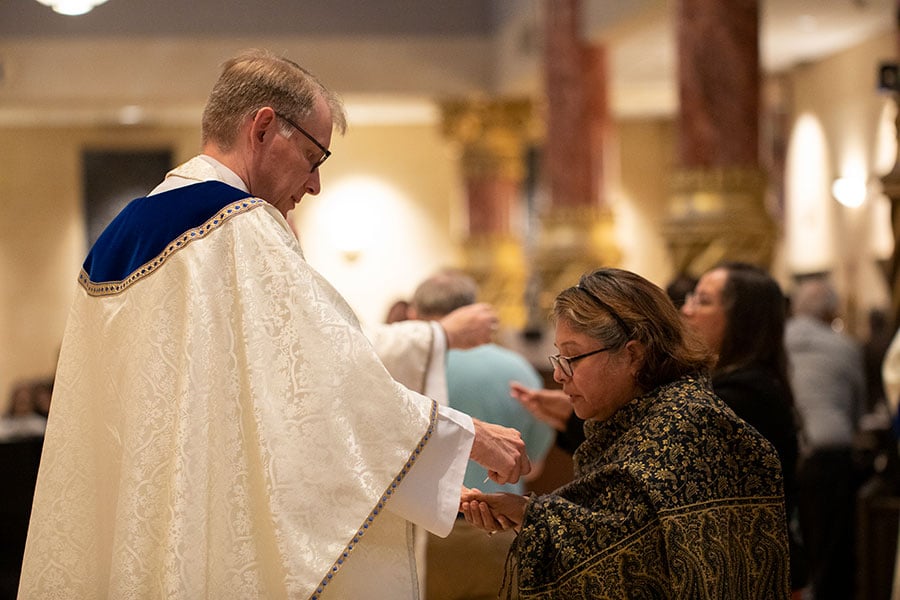Common acts of the assembly during the celebration of Mass

Very Rev. Jonathan C. Wallis presents the Eucharist to a parishioner.
In previous installments of “Understanding the Mystery,” Father Thu Nguyen explained why we sit, stand, and kneel during Mass, as well as the meaning of the Sign of the Cross. Here, the diocesan director of liturgy continues to explain the deeper meanings behind common acts of the assembly during the celebration of Mass.
Let’s start by asking why the Catholic Church incorporates our bodies into our worship of God?
Fr. Nguyen: You and I, as humans, communicate with each other through external gestures. I look at you; I move my hands; we express ourselves through movements.
We are creatures of body as well as spirit. When we communicate with God, we worship by raising our hearts and mind, so our whole person is praying with body and mind. It helps us pray with greater attentiveness. That's why all the gestures prescribed in the ritual have profound meaning.
The Holy Eucharist is the Source and Summit of our faith. Do the faithful understand how to receive the Eucharist?
Fr. Nguyen: The communicant may choose whether to receive the body of Christ in the hand or on the tongue according to the directive of the “General Instruction of the Roman Missal” and especially adapted by the U.S. Conference of Catholic Bishops — both methods with a spirit of reverence and a profession of belief for the real presence of Our Lord Jesus.
Some people are surprised that receiving in the hand goes back to the earliest days of the Church, beginning with Jesus and the Apostles at the Last Supper.
When receiving in the hand, the communicant needs to be guided by the words of St. Cyril of Jerusalem. Writing in the fourth century, he said to put your right hand beneath your left hand, which serves as a throne to receive our King. Keep your fingers together, taking care that nothing is lost, and consume Him right away.
We bow our heads reverently before receiving. Afterwards, step on either side and consume immediately without making any gestures to the Body of Christ. It is sacrilegious to do anything to the Host, such as returning to the pew carrying the Eucharist.
What are appropriate ways to extend the Sign of Peace?

Fr. Nguyen: According to Rome, the essential meaning of the Sign of Peace is not a moment of wishing your neighbor well, or a social moment of visitation.
The purpose of the rite of peace in the Church is peace and unity for herself and the whole human being. It's not a moment of acquaintance, where we ask, “Hi, how are you?”
It is a sign of extending charity and unity to each other.
Sometimes the assembly falls into an occasion of greeting, becoming acquainted at that moment, and then some individuals even run all over shaking hands and hugging. That’s not what the “General Instruction of the Roman Missal” recommends. You only extend the peace quietly to the nearest person around you, left and right, front and back, depending on the custom prescribed by the USCCB.
Is it appropriate to clap during Mass for the homily, choir, or a guest speaker?
Fr. Nguyen: : As explained by our beloved Pope Benedict XVI in “The Spirit of Liturgy,” the liturgy comes from God. It's not our social gathering; it is our gathering to worship God. Anything that breaks the flow of liturgy becomes disturbing and inserted for our own purpose.
What does clapping mean? You recognize whatever is great about this moment or this person — the choir sings wonderfully, and so on. Maybe it’s congratulations or a birthday. All these intrusive gestures break the importance of liturgy.
If you say the choir is wonderful, you can congratulate them afterward. But are they really there to perform for you?
There’s one moment in a liturgical ceremony that we acknowledge by clapping, according to the ritual of the Ordination of the Priesthood. You have the young man, and his superiors testify that he's ready to be ordained. Then he is presented to the assembly, and the bishop calls for applause.
Why is silence important during Mass?
Fr. Nguyen: Many moments in the liturgy require a moment of silence: after the readings and after the homily. These moments are pauses for us to meditate and digest what we have heard. Another moment of silence is right after Communion to reflect on what we have been given, to offer thanksgiving for the Body and Blood.
The silence reminds us of Luke 2:19, “Mary kept all these things, reflecting on them in her heart.” During silence at Mass, you can reflect on all these things you have been given.
